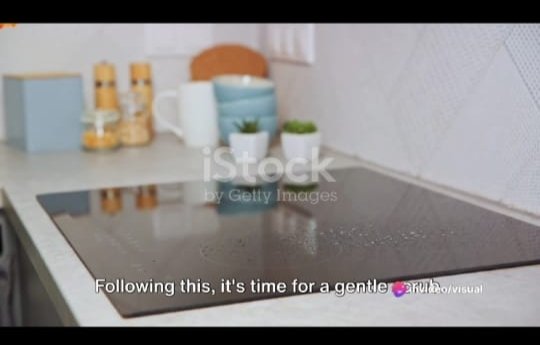A glass stove top adds a touch of modernity and sophistication to any kitchen, but keeping it clean and pristine can be a challenge. With daily cooking activities, spills, and grease, maintaining the crystal-clear appearance of your glass stove top takes a little effort and the right techniques. In this comprehensive guide, we’ll explore various methods and tips to effectively clean a glass stove top, ensuring it not only looks good but also performs at its best.
Table of Contents
1. Understanding Your Glass Stove Top

Before considering cleaning methods, it is important to understand the structure of your glass stove top. Most modern glass stove tops are made of ceramic glass, which is a durable and heat-resistant material. This type of surface is prone to scratches, so it is important to use non-abrasive cleaning methods and tools.
2. Tools and Materials You’ll Need

Before you begin your glass cleaning journey, gather the following tools and ingredients that will transform your kitchen into a stage for culinary genius.
Soft, lint-free microfiber cloth
mild dish soap
white vinegar
baking soda
razor blade scraper
non-abrasive scrubbing pads
Cooktop Cleaner (Ceramic-Safe)
3. daily maintenance routine
Wipe up spills promptly: The key to maintaining a clean glass stove top is to wipe up spills and stains promptly. Use a soft, damp microfiber cloth to wipe up any spills while the surface is still warm.
Avoid Abrasive Materials: Never use abrasive materials such as steel wool or hard scouring pads, as they can scratch the glass surface. Use soft materials and non-abrasive cleaning solutions.
4. Regular cleaning methods
Soap and water:
One. Add a few drops of mild dish soap to warm water, creating a soothing mixture for your glass stove top.
B. Soak a microfiber cloth in soapy water and gently wipe the entire surface.
C. Rinse the cloth thoroughly to remove any soap residue and wipe again.
Vinegar and water solution:
One. Prepare a harmonious mixture by combining equal amounts of pristine white vinegar and water within a sparkling spray bottle.
B. Spray the solution on the glass surface.
C. Wipe the surface with a damp microfiber cloth to remove stains and grease.
Baking Soda Paste:
One. Mix baking soda with water to make a thick paste.
B. Apply the paste on stubborn stains and leave it for 15-20 minutes.
C. Gently scrub the area with a non-abrasive scrubbing pad.
D. Wipe the paste with a wet cloth.
5. Dealing with tough stains
Razor Blade Scraper:
One. For tough, caked-on stains, use a razor blade scraper at a 45-degree angle.
B. Gently scrape off the residue, being careful not to scratch the surface.
C. Wipe the area with a damp cloth to remove any remaining debris.
Specialized Cooktop Cleaner:
One. Use a cooktop cleaner specifically designed for ceramic glass surfaces.
B. Follow manufacturer’s instructions for installation and removal.
6. Preventive Measures
Use flat-bottomed cookware: Make sure your cookware has a flat, smooth bottom to avoid scratching the glass surface.
Regular Maintenance: Incorporate regular cleaning into your kitchen routine to prevent stains and deposits.
Cool before cleaning: Always allow the glass stove to cool before cleaning to avoid thermal shock.
Steam cleaning:
One. Boil water in a vessel on the stove.
B. Let the steam loosen up grime and stains.
C. Carefully wipe away loose debris with a microfiber cloth.
Citrus Power:
One. Cut a lemon in half and dip it in baking soda.
B. Scrub glass stove tops using half of a lemon to take advantage of the natural acidity and abrasive properties.
C. Wipe away residue with a damp cloth.
Hydrogen Peroxide Solution:
One. Mix equal amounts of hydrogen peroxide and water.
B. Apply the solution on the stained area and leave it for 10-15 minutes.
C. Rub gently with a non-abrasive pad and clean.
7. troubleshooting common problems
Scratch Repair:
One. For light scratches, try using a special glass scratch repair kit.
B. Follow the kit’s instructions carefully to minimize the appearance of scratches.
Mineral deposits:
One. Remove mineral deposits caused by hard water using a cloth soaked in vinegar.
B. Wipe the affected areas and wipe the surface with a dry cloth to restore the shine.
Persistent stains:
One. Mix a paste of baking soda and water.
B. Apply the paste on the stain and cover it with a wet cloth.
C. Let it sit overnight before scrubbing and cleaning.
8. Additional Tips for Maintenance
Use caution with cast iron and stone cookware:
One. Be careful when using cast iron or stoneware cookware, as they can potentially scratch the glass surface.
B. Place a barrier between the cookware and the glass, such as a heat-resistant trivet.
Replace burner drip bowls regularly:
One. Burner drip bowls can collect spills and grease.
B. Replace these bowls regularly to prevent residue from accumulating on the glass surface.
9. conclusion
In conclusion, maintaining a glass stove in pristine condition involves a combination of regular care, effective cleaning methods, and preventative measures. Whether dealing with daily spills or stubborn stains, the key is to be proactive and gentle in your approach. By incorporating the tips and techniques discussed in this comprehensive guide into your cleaning routine, you will not only keep your glass stove shining brightly but also extend its lifespan.
Remember that consistency is key. Develop a regular cleaning schedule to prevent build-up and address problems promptly. Keep in mind the importance of using non-abrasive materials for cleaning products and following manufacturer recommendations. With the right care and attention, your glass stove top can remain a focal point in your kitchen, adding both style and functionality.
Finally, stay informed about any updates or specific recommendations from the manufacturer regarding the care and maintenance of your specific glass stove top model. Each appliance may have unique features or requirements, so tailoring your cleaning routine to meet those specifications will contribute to the long-term success of your glass stove top. Happy cleaning!
Maintaining a gleaming glass stove top requires a combination of daily care and periodic deep cleaning. By following the tips and methods outlined in this guide, you can keep your glass stove top looking as good as new and ensure its longevity. Remember to be gentle, use non-abrasive materials, and repair leaks promptly to enjoy the beauty and functionality of your glass stove top for years to come.
Seventh. Advanced Cleaning Technologies
